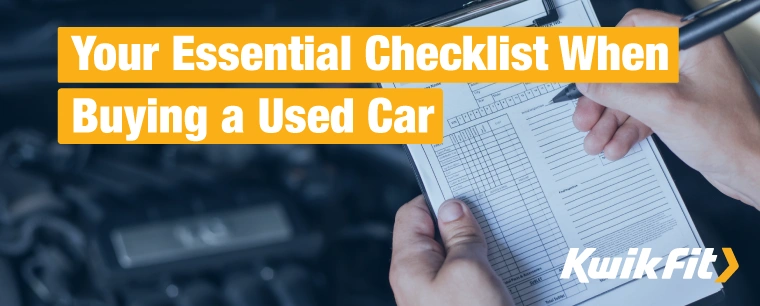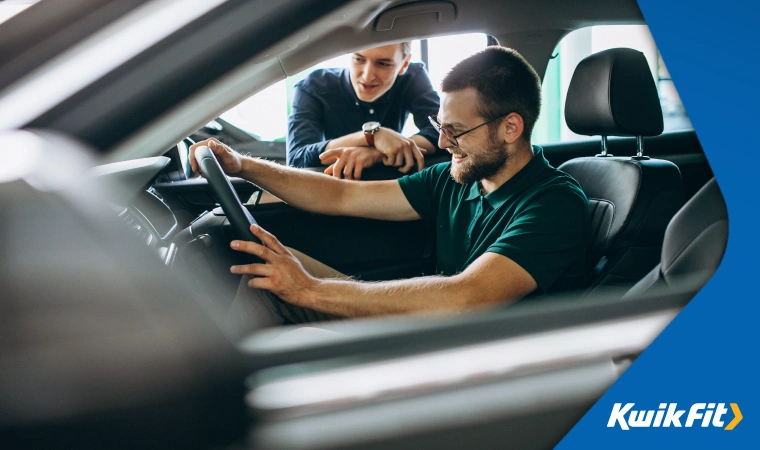Your essential checklist when buying a used car
Jack Dreyer | Tuesday 25th October 2022 2:15pm

Buying a used car can be a great way to bag yourself a bargain, but itís not without its risks. So, if youíre planning to purchase a second-hand vehicle, itís essential that you know what youíre doing. To help you avoid making potentially costly mistakes, hereís your essential checklist when youíre choosing a used car.
General condition
If you see a car that looks just right for you - and one that seems to offer great value for money - itís easy to get carried away and part with your cash without thoroughly checking its condition.
To ensure you donít fall into this trap, it helps to have a list of potential problems to look out for. For example, are the tyres in decent condition and all of the appropriate size and specification? Bear in mind that if the tyres have a tread depth of less than 3mm, theyíll probably have to be replaced soon.
Do all of the seatbelts work properly, and are there signs of damage or fraying that could affect how well they function? Are all the lights and the windscreen washers and wipers working as they should? Do the locks, including central and remote controlled locks, function correctly? Do all the windows open and close smoothly?
If there is supposed to be a spare tyre, make sure this is in place too, or if there's a tyre sealant kit and inflator, check that theyíre in a serviceable condition. Ensure the jack is present as well.
Itís also important to keep your eyes peeled for signs of forced entry to the car, or indications that the locks have been replaced. In addition, if airbags are fitted, check that the warning lights behave as the handbook suggests they will. Usually, these lights switch on and off when you turn on the ignition.
If you can, arrange to view the vehicle during daylight hours as itís much easier to spot problems when itís light. Ideally, you should inspect the car when itís dry too. Itís more difficult to see signs of damage if the vehicleís wet.
Test drive

You should never hand over your money for a used motor without taking it for a test drive first. Bear in mind youíll need insurance to do this. If you already have your own cover for an existing car, check with your insurance providers to see if youíre allowed to drive someone elseís vehicle. If you donít have insurance, a private seller or traderís policy might cover you - but ask them about this before you get behind the wheel.
Your test drive should be at least 15 minutes long and you should have the opportunity to drive on different types of roads so that you can see how the car performs at various speeds. As well as paying attention to the general smoothness and feel of the ride, make sure you look out for a variety of possible red flags. For instance, do the warning lights work normally? Are there unusual noises when you press the brake pedal? Is the steering pulling to one side? Does the handbrake seem slack? Can you hear strange noises when you start the engine from cold? Do the exhaust emissions seem excessive?
If you notice any issues when youíre in the driving seat, this probably isnít the car for you.
Vehicle history
Physically inspecting and testing a car is only part of the story when youíre investigating whether itís a savvy purchase. Youíll also need to do some checks into the vehicleís history. This will help you to establish whether itís been sold illegally or has had big repairs in the past.
Check the carís registration number, MOT test number, make and model, mileage and V5C registration certificate with the DVLA to ensure they tally up with what the vendor is telling you. You can do this online using the DVLAís vehicle information checker. Ensure that the car has had regular MOT tests too.
While an MOT history isnít a marker of the current quality of the vehicle, it can give you pointers on the type of driver who owns it. If, for example, the carís had repeated clutch & gasket issues Ė it could be an unlucky car or it could be an aggressive driver. This, in turn, could indicate other excessive wear in other parts (such as CV joints) from poor driving habits.
Itís also a good idea to get a private history check done. Also called a Ďdata checkí, this can cost up to £20, but itís well worth it as it can flag up any serious problems the car might have had. This includes whether itís been reported stolen, itís been written off and then returned to the road, itís showing an incorrect mileage or the seller still owes money on it.
Seller's credentials
The safest way to buy a used car is to go to an established trader with a good reputation. Look out for a trade association sign (such as the Retail Motor Industry Federation) or evidence that the company follows the code of practice set out by The Motor Ombudsman.
Auctions donít offer as much consumer protection, so if you decide to buy a car in this way, make sure you read over the auction houseís terms and conditions very carefully before you start bidding.
If youíre buying from a private seller, itís helpful if you can agree to meet at their home rather than in a public place. This means that if anything goes wrong once youíve made the purchase, you at least have a record of their address in order to contact them.
And now to negotiate...

Following this checklist should mean youíre able to avoid accidentally buying a banger or experiencing any other unwelcome surprises. However, youíll still need to make sure you negotiate yourself a good deal.
To help with this, get stuck into some research before you meet the seller. Look into how the asking price of the car compares to other similar vehicles currently being sold. Have a clear budget in mind too - and stick to it. This means being prepared to walk away if youíre not happy with the deal - even if you love the car.
Regardless of who youíre buying from, itís always important to be fair and polite. If youíre too unrealistic or aggressive in your haggling, you might miss out on a bargain.
Need a second opinion?
If youíve just bought a used car, itís best to take it to your local Kwik Fit centre for an inspection - just to be sure!
Any facts, figures and prices shown in our blog articles are correct at time of publication.
Featured Articles
Is it Illegal to Drive With One Headlight?
Saturday 19th July 2025
Wondering if itís illegal to drive with one headlight? Learn about the safety risks and penalties of illegal blown bulbs and why you should fix them promptly.
Air Con in EVs & Hybrids: Experts Answer Your Questions
Monday 30th June 2025
Does air con drain EV batteries? Can you use the air con while charging an electric car? Find out the answers to these questions & more from Kwik Fitís experts.
Why Is Your Car Making a Noise? Fixes & Tips
Friday 13th June 2025
When your car starts making unexpected noises, it can certainly be quite disconcerting; it may be nothing to worry about, but hereís what you need to know.









